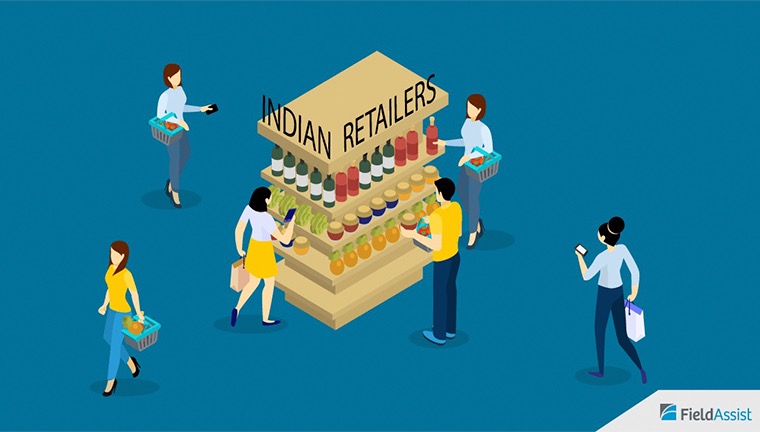Table of Contents
ToggleAs the Indian FMCG industry stands prepared for a new future driven by growing consumption, supportive regulation and improving infrastructure, Indian retailers at large are delivering double digit growth rates. However, they also realize that in order to scale and grow profitably, they must do things differently and a. Very few of them have been able to adapt to technology driven FMCG industry and crack the profitability code. A recent research by @PwC reveals that over 85% retailers have not been able to pace up and had to rethink their strategy and value proposition.
The $600 billion Indian retail market continues to be driven largely by unorganized players. The figures may seem skewed to believe but research suggests that nearly 93% retailing still happens through mom and pop outlets or stand-alone stores. Organized retail therefore accounts for only 7-8% of the retail market. For a better understanding, it would be insightful to compare these numbers with South East Asian markets where unorganized and organized retail accounts for 32% and 68% respectively. The figures therefore indicate tremendous scope of growth for organized retail in India.
The shift to large format stores in the past decade has boosted expansion and sales for retail majors. According to analysts at brokerage firm Jefferies, GST (goods and services tax) and Demonetization were levers for the organized retail in India allowing them to vying for a fair share from unorganized trade. Organized retail players in their quest to achieve profitability and judicious scale up expansion plans have therefore retooled their business model owing to their decade long learning.
In this context, one cannot disregard the significance of unique drivers leading to this rapid growth of organized retail formats.
Consumption growth in young urban consumers
India is slated to be the youngest country by 2020 since 47% if its population is below 25yrs of age. Therefore, factors such as rising urbanization and the growing participation of women in workforce has given way to consumer block that is likely to pay a premium for convenience. In addition, rise in nuclear families have also resulted in 20-30% increased spends than joint families. Notably, 70% of the households today have a nuclear structure which is nearly 15% higher than past 2 decades.
Digital influence
With the rise in smartphone usage, digital penetration in India is growing rapidly. A whopping 13% Indian population uses smartphones today implying the level of digital literacy in India.
Growth in Aspirations
Rising disposable incomes in the urban consumer segment has led to growing aspirations. The modern consumer is willing to up grade to branded products and pay for the additional service and convenience. Focus on healthier lifestyle, increased awareness of global products and a shift in demographic structure has driven the aspirational trends in the country.
Improved Regulatory Environment
Relaxed FDI rules for retail has enabled global players to enter the Indian market. Backed with heavy investments, back-end infrastructure such as warehouses and logistics has led to employment creation across the country.
The above factors may establish the fact that organized retail is an attractive proposition in business today. However, they continue to struggle. Research reports suggests that organised retail in India was projected to grow to 21% by 2015 and 24% by 2020. However, even in 2015, that number stood at 8%. This period witnessed operation shutdowns, store closures and exits by some large global retailers too. On-ground realities were different than envisioned, hence they could not achieve their projected scale.
Retail majors are all set to ride on the retail wave by recognizing key trends and earn the first mover advantage with respect to competition. The Indian organized retail industry has huge potential today owing to rising product and quality consciousness among consumers. This growth is achievable if retailers develop their ability to reinvent and stay ahead of competition through technological innovations. Higher dependencies on digital technology among consumers is leading to newer shopping experiences in physical stores. As a result, large format retail players are adapting to new technological trends such.
Some of these trends include:
Omnichannel Retailing
Proliferation of multiple channels to provide a unique and consistent shopping experience to consumers through omnichannel marketing.
In-store Analytics
Leveraging on the physical presence of a consumer to study their behavior, travel paths, heat maps and use this to enhance better in-store experience.
Evolution of Experience Stores
Physical stores for e-commerce websites where customers can see the product first hand but place their orders in the store. Also known as “Reverse Showrooming”, this trend aims at creating DELIGHT value for the customer.
Personalization
Online engagement with consumers can be used to collect data about consumer preferences and transaction histories. Through these constant innovations, clear differentiators are created by retailers to show how their value proposition causes a visible shift in excellent customer experience. In the long term, industry outlook appears positive ably supported by rising disposable incomes, increased urbanization and influx of international brands.
About Post Author
Rashmi Kapse
Rashmi is a Content Specialist at FieldAssist. After spending 11 years in the Executive Search business she decided to change tracks and follow her passion for writing. For the past 8 years, she has been writing on Sales Tech, HR Tech, FMCG, Consumer Goods, F&B and Health & Wellness.




